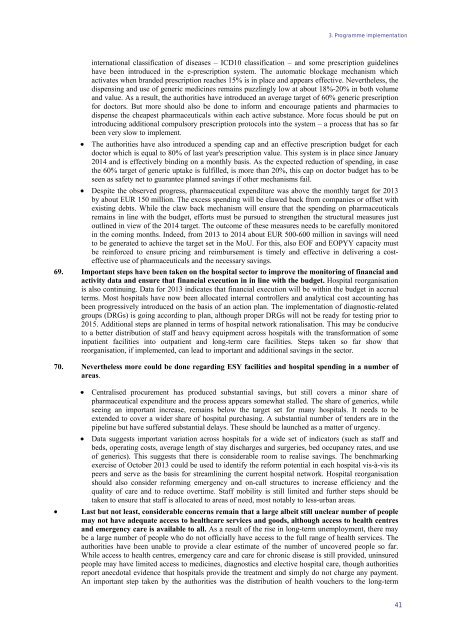ocp192_en
ocp192_en
ocp192_en
Create successful ePaper yourself
Turn your PDF publications into a flip-book with our unique Google optimized e-Paper software.
3. Programme implem<strong>en</strong>tationinternational classification of diseases – ICD10 classification – and some prescription guidelineshave be<strong>en</strong> introduced in the e-prescription system. The automatic blockage mechanism whichactivates wh<strong>en</strong> branded prescription reaches 15% is in place and appears effective. Nevertheless, thedisp<strong>en</strong>sing and use of g<strong>en</strong>eric medicines remains puzzlingly low at about 18%-20% in both volumeand value. As a result, the authorities have introduced an average target of 60% g<strong>en</strong>eric prescriptionfor doctors. But more should also be done to inform and <strong>en</strong>courage pati<strong>en</strong>ts and pharmacies todisp<strong>en</strong>se the cheapest pharmaceuticals within each active substance. More focus should be put onintroducing additional compulsory prescription protocols into the system – a process that has so farbe<strong>en</strong> very slow to implem<strong>en</strong>t.• The authorities have also introduced a sp<strong>en</strong>ding cap and an effective prescription budget for eachdoctor which is equal to 80% of last year's prescription value. This system is in place since January2014 and is effectively binding on a monthly basis. As the expected reduction of sp<strong>en</strong>ding, in casethe 60% target of g<strong>en</strong>eric uptake is fulfilled, is more than 20%, this cap on doctor budget has to bese<strong>en</strong> as safety net to guarantee planned savings if other mechanisms fail.• Despite the observed progress, pharmaceutical exp<strong>en</strong>diture was above the monthly target for 2013by about EUR 150 million. The excess sp<strong>en</strong>ding will be clawed back from companies or offset withexisting debts. While the claw back mechanism will <strong>en</strong>sure that the sp<strong>en</strong>ding on pharmaceuticalsremains in line with the budget, efforts must be pursued to str<strong>en</strong>gth<strong>en</strong> the structural measures justoutlined in view of the 2014 target. The outcome of these measures needs to be carefully monitoredin the coming months. Indeed, from 2013 to 2014 about EUR 500-600 million in savings will needto be g<strong>en</strong>erated to achieve the target set in the MoU. For this, also EOF and EOPYY capacity mustbe reinforced to <strong>en</strong>sure pricing and reimbursem<strong>en</strong>t is timely and effective in delivering a costeffectiveuse of pharmaceuticals and the necessary savings.69. Important steps have be<strong>en</strong> tak<strong>en</strong> on the hospital sector to improve the monitoring of financial andactivity data and <strong>en</strong>sure that financial execution in in line with the budget. Hospital reorganisationis also continuing. Data for 2013 indicates that financial execution will be within the budget in accrualterms. Most hospitals have now be<strong>en</strong> allocated internal controllers and analytical cost accounting hasbe<strong>en</strong> progressively introduced on the basis of an action plan. The implem<strong>en</strong>tation of diagnostic-relatedgroups (DRGs) is going according to plan, although proper DRGs will not be ready for testing prior to2015. Additional steps are planned in terms of hospital network rationalisation. This may be conduciveto a better distribution of staff and heavy equipm<strong>en</strong>t across hospitals with the transformation of someinpati<strong>en</strong>t facilities into outpati<strong>en</strong>t and long-term care facilities. Steps tak<strong>en</strong> so far show thatreorganisation, if implem<strong>en</strong>ted, can lead to important and additional savings in the sector.70. Nevertheless more could be done regarding ESY facilities and hospital sp<strong>en</strong>ding in a number ofareas.• C<strong>en</strong>tralised procurem<strong>en</strong>t has produced substantial savings, but still covers a minor share ofpharmaceutical exp<strong>en</strong>diture and the process appears somewhat stalled. The share of g<strong>en</strong>erics, whileseeing an important increase, remains below the target set for many hospitals. It needs to beext<strong>en</strong>ded to cover a wider share of hospital purchasing. A substantial number of t<strong>en</strong>ders are in thepipeline but have suffered substantial delays. These should be launched as a matter of urg<strong>en</strong>cy.• Data suggests important variation across hospitals for a wide set of indicators (such as staff andbeds, operating costs, average l<strong>en</strong>gth of stay discharges and surgeries, bed occupancy rates, and useof g<strong>en</strong>erics). This suggests that there is considerable room to realise savings. The b<strong>en</strong>chmarkingexercise of October 2013 could be used to id<strong>en</strong>tify the reform pot<strong>en</strong>tial in each hospital vis-à-vis itspeers and serve as the basis for streamlining the curr<strong>en</strong>t hospital network. Hospital reorganisationshould also consider reforming emerg<strong>en</strong>cy and on-call structures to increase effici<strong>en</strong>cy and thequality of care and to reduce overtime. Staff mobility is still limited and further steps should betak<strong>en</strong> to <strong>en</strong>sure that staff is allocated to areas of need, most notably to less-urban areas.• Last but not least, considerable concerns remain that a large albeit still unclear number of peoplemay not have adequate access to healthcare services and goods, although access to health c<strong>en</strong>tresand emerg<strong>en</strong>cy care is available to all. As a result of the rise in long-term unemploym<strong>en</strong>t, there maybe a large number of people who do not officially have access to the full range of health services. Theauthorities have be<strong>en</strong> unable to provide a clear estimate of the number of uncovered people so far.While access to health c<strong>en</strong>tres, emerg<strong>en</strong>cy care and care for chronic disease is still provided, uninsuredpeople may have limited access to medicines, diagnostics and elective hospital care, though authoritiesreport anecdotal evid<strong>en</strong>ce that hospitals provide the treatm<strong>en</strong>t and simply do not charge any paym<strong>en</strong>t.An important step tak<strong>en</strong> by the authorities was the distribution of health vouchers to the long-term41


